Company Valuation Assignment : Dupont Corporation
Added on 2020-12-10
44 Pages14181 Words485 Views
Company Valuation

TABLE OF CONTENTS
TABLE OF CONTENTS................................................................................................................2
PART 1............................................................................................................................................1
Q.4 Estimating the ROE of the company for five years by using DU PONT ROE approach....1
PART 2............................................................................................................................................2
Q.2 Estimating share price using dividend discount model (DDM) for estimating intrinsic
value of the company...................................................................................................................2
REFERENCES................................................................................................................................4
APPENDIX......................................................................................................................................5
TABLE OF CONTENTS................................................................................................................2
PART 1............................................................................................................................................1
Q.4 Estimating the ROE of the company for five years by using DU PONT ROE approach....1
PART 2............................................................................................................................................2
Q.2 Estimating share price using dividend discount model (DDM) for estimating intrinsic
value of the company...................................................................................................................2
REFERENCES................................................................................................................................4
APPENDIX......................................................................................................................................5
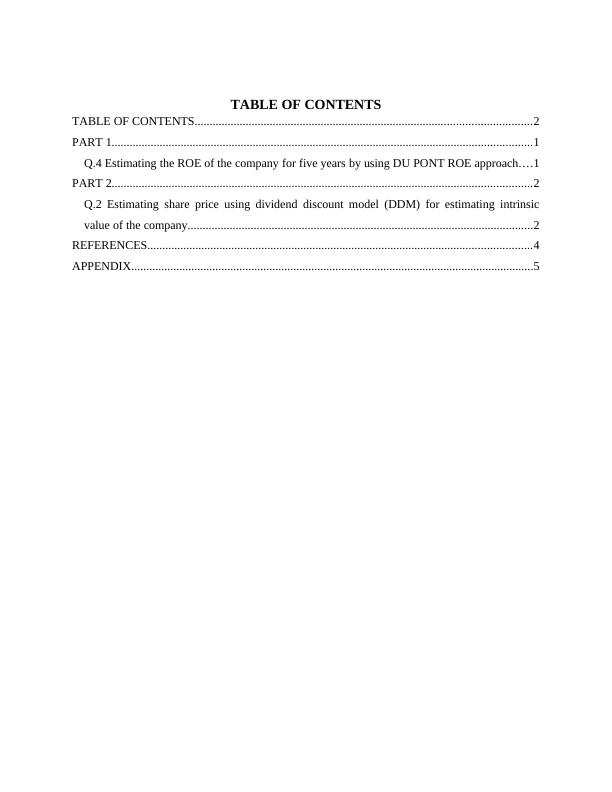
PART 1
Q.4 Estimating the ROE of the company for five years by using DU PONT ROE approach
DuPont analysis sometimes also called as DuPont identity or DuPont model is a system
for interpreting and analysing the fundamental performance of a company. The model was
created by the Dupont Corporation way back in the year 1920. The analysis can be seen as the
extended version of the examination of Return on equity (ROE) of a business entity which
examines the net profit margin, asset turnover and financial leverage (Anwar, Fathoni and
Gagah, 2018). In other words, it can be described as evaluating and analysing of ROE of a
company for ascertaining how it can increase its return for its equity shareholders.
Return on equity ( by Dupont approach) = Net profit margin* Asset turnover
ratio* financial leverage
= (Net profit/sales)*(sales/total assets)*(total assets/total equity)
Profit margin ratio : (AUS millions)
(Net profit/ sales)
2014 2015 2016 2017 2018
Net profit 206.9 256.6 244.6 230.8 262.9
sales 2244.6 2397 2641.8 2769.7 2950
Profit margin
ratio 9.22% 10.71% 9.26% 8.33% 8.91%
Total asset turnover :
(sales/avg. Total
assets)
2014 2015 2016 2017 2018
sales 2244.6 2397 2641.8 2769.7 2950
Average Total
assets 3577.7 3804.4 4397.2 4697.1 4908
Total asset
turnover 0.63 0.63 0.60 0.59 0.60
Financial leverage :
(Total assets/total 2014 2015 2016 2017 2018
1
Q.4 Estimating the ROE of the company for five years by using DU PONT ROE approach
DuPont analysis sometimes also called as DuPont identity or DuPont model is a system
for interpreting and analysing the fundamental performance of a company. The model was
created by the Dupont Corporation way back in the year 1920. The analysis can be seen as the
extended version of the examination of Return on equity (ROE) of a business entity which
examines the net profit margin, asset turnover and financial leverage (Anwar, Fathoni and
Gagah, 2018). In other words, it can be described as evaluating and analysing of ROE of a
company for ascertaining how it can increase its return for its equity shareholders.
Return on equity ( by Dupont approach) = Net profit margin* Asset turnover
ratio* financial leverage
= (Net profit/sales)*(sales/total assets)*(total assets/total equity)
Profit margin ratio : (AUS millions)
(Net profit/ sales)
2014 2015 2016 2017 2018
Net profit 206.9 256.6 244.6 230.8 262.9
sales 2244.6 2397 2641.8 2769.7 2950
Profit margin
ratio 9.22% 10.71% 9.26% 8.33% 8.91%
Total asset turnover :
(sales/avg. Total
assets)
2014 2015 2016 2017 2018
sales 2244.6 2397 2641.8 2769.7 2950
Average Total
assets 3577.7 3804.4 4397.2 4697.1 4908
Total asset
turnover 0.63 0.63 0.60 0.59 0.60
Financial leverage :
(Total assets/total 2014 2015 2016 2017 2018
1
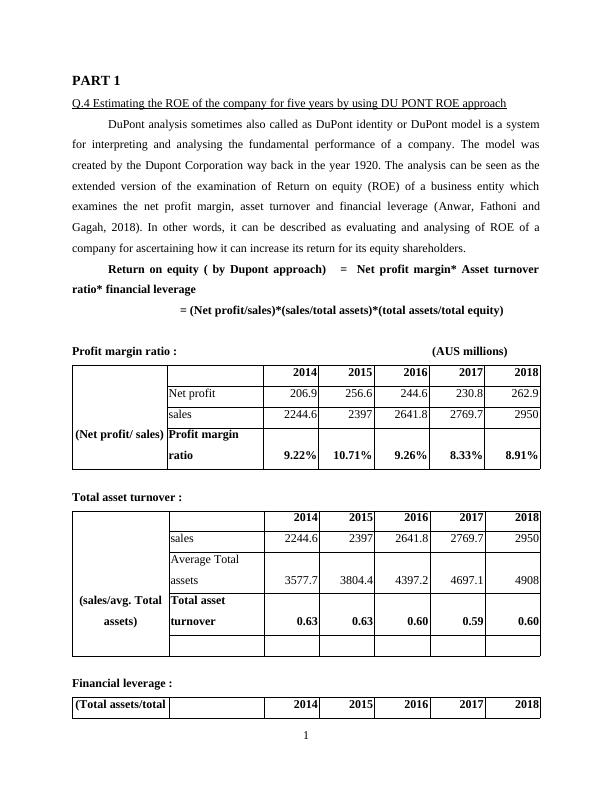
equity)
Total assets 2410.4 2788 3003.2 3195.5 3425
Total equity 1097.8 1270.1 1346.9 1428.8 1535.9
Financial
leverage 2.20 2.20 2.23 2.24 2.23
Return on equity :
( DuPont analysis)
(DuPont analysis)
2014 2015 2016 2017 2018
Profit margin ratio 9.22% 10.71% 9.26% 8.33% 8.91%
Total asset
turnover 0.63 0.63 0.60 0.59 0.60
Financial leverage 2.20 2.20 2.23 2.24 2.23
ROE 12.78% 14.84% 12.39% 11.01% 11.92%
WEBJET
Profit margin ratio :
2014 2015 2016 2017 2018
Net profit 19 18 22 52 41
sales 95 117 152 199 752
Profit margin
ratio 20.00% 15.38% 14.47% 26.13% 5.45%
Total asset turnover :
2014 2015 2016 2017 2018
sales 95 117 152 199 752
Average Total
assets 198.5 230.5 479.5 624.5 1330.5
Total asset
turnover 0.48 0.51 0.32 0.32 0.57
Financial leverage :
2014 2015 2016 2017 2018
2
Total assets 2410.4 2788 3003.2 3195.5 3425
Total equity 1097.8 1270.1 1346.9 1428.8 1535.9
Financial
leverage 2.20 2.20 2.23 2.24 2.23
Return on equity :
( DuPont analysis)
(DuPont analysis)
2014 2015 2016 2017 2018
Profit margin ratio 9.22% 10.71% 9.26% 8.33% 8.91%
Total asset
turnover 0.63 0.63 0.60 0.59 0.60
Financial leverage 2.20 2.20 2.23 2.24 2.23
ROE 12.78% 14.84% 12.39% 11.01% 11.92%
WEBJET
Profit margin ratio :
2014 2015 2016 2017 2018
Net profit 19 18 22 52 41
sales 95 117 152 199 752
Profit margin
ratio 20.00% 15.38% 14.47% 26.13% 5.45%
Total asset turnover :
2014 2015 2016 2017 2018
sales 95 117 152 199 752
Average Total
assets 198.5 230.5 479.5 624.5 1330.5
Total asset
turnover 0.48 0.51 0.32 0.32 0.57
Financial leverage :
2014 2015 2016 2017 2018
2
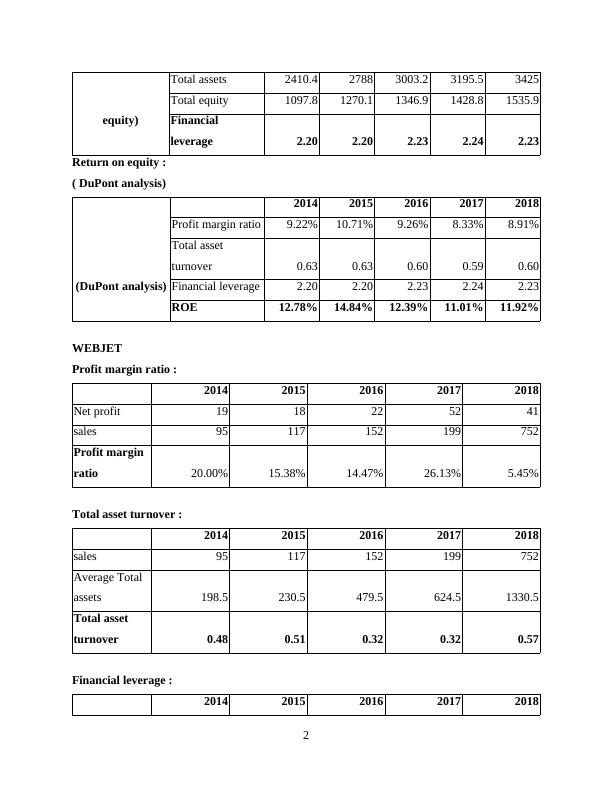
Total assets 129 203 378 493 1084
Total equity 69 82 152 216 443
Financial
leverage 1.87 2.48 2.49 2.28 2.45
DuPont Analysis
2014 2015 2016 2017 2018
Profit margin
ratio 20.00% 15.38% 14.47% 26.13% 5.45%
Total asset
turnover 0.48 0.51 0.32 0.32 0.57
Financial
leverage 1.87 2.48 2.49 2.28 2.45
ROE 17.95% 19.45% 11.53% 19.06% 7.61%
HELLO WORLD
Profit margin ratio :
2014 2015 2016 2017 2018
Net profit -63 -201 2 22 32
sales 286 274 292 322 323
Profit margin
ratio -22.03% -73.36% 0.68% 6.83% 9.91%
Total asset turnover :
2014 2015 2016 2017 2018
sales 286 274 292 322 323
Average Total
assets 1146.5 918.5 699.5 962 1017.5
Total asset
turnover 0.25 0.30 0.42 0.33 0.32
3
Total equity 69 82 152 216 443
Financial
leverage 1.87 2.48 2.49 2.28 2.45
DuPont Analysis
2014 2015 2016 2017 2018
Profit margin
ratio 20.00% 15.38% 14.47% 26.13% 5.45%
Total asset
turnover 0.48 0.51 0.32 0.32 0.57
Financial
leverage 1.87 2.48 2.49 2.28 2.45
ROE 17.95% 19.45% 11.53% 19.06% 7.61%
HELLO WORLD
Profit margin ratio :
2014 2015 2016 2017 2018
Net profit -63 -201 2 22 32
sales 286 274 292 322 323
Profit margin
ratio -22.03% -73.36% 0.68% 6.83% 9.91%
Total asset turnover :
2014 2015 2016 2017 2018
sales 286 274 292 322 323
Average Total
assets 1146.5 918.5 699.5 962 1017.5
Total asset
turnover 0.25 0.30 0.42 0.33 0.32
3
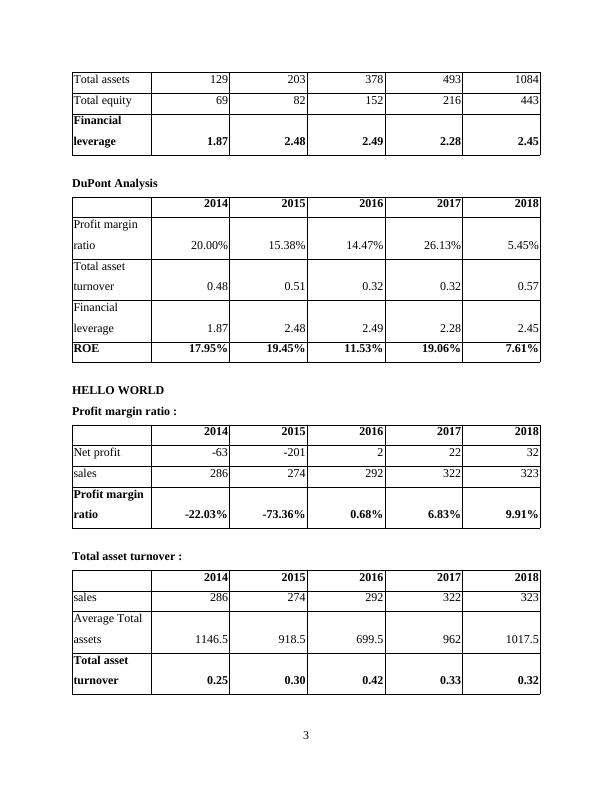
Financial leverage :
2014 2015 2016 2017 2018
Total assets 683 471 646 639 698
Total equity 377 177 266 279 301
Financial
leverage 1.81 2.66 2.43 2.29 2.32
DuPont Analysis :
2014 2015 2016 2017 2018
Profit margin
ratio -22.03% -73.36% 0.68% 6.83% 9.91%
Total asset
turnover 0.25 0.3 0.42 0.33 0.32
Financial
leverage 1.81 2.66 2.43 2.29 2.32
ROE -9.97% -58.54% 0.69% 5.16% 7.36%
DuPont Analysis of FLT, Hello World and Webjet
Companies
(ROE)
2014 2015 2016 2017 2018
FLT 12.78% 14.84% 12.39% 11.01% 11.92%
Webjet 17.95% 19.45% 11.53% 19.06% 7.61%
Hello World -9.97% -58.54% 0.69% 5.16% 7.36%
Interpretation : From the above DuPont analysis, it can be seen that return on equity of
Flight Centre Travel Group (FLT) for the recent five years starting from 2014 to 2018 is 12.78%,
14.84%, 12.39%, 11.01%, 11.92% respectively. ROE is the ratio that measures the income
earned for the shareholders against the investments made by them in the company. DuPont
4
2014 2015 2016 2017 2018
Total assets 683 471 646 639 698
Total equity 377 177 266 279 301
Financial
leverage 1.81 2.66 2.43 2.29 2.32
DuPont Analysis :
2014 2015 2016 2017 2018
Profit margin
ratio -22.03% -73.36% 0.68% 6.83% 9.91%
Total asset
turnover 0.25 0.3 0.42 0.33 0.32
Financial
leverage 1.81 2.66 2.43 2.29 2.32
ROE -9.97% -58.54% 0.69% 5.16% 7.36%
DuPont Analysis of FLT, Hello World and Webjet
Companies
(ROE)
2014 2015 2016 2017 2018
FLT 12.78% 14.84% 12.39% 11.01% 11.92%
Webjet 17.95% 19.45% 11.53% 19.06% 7.61%
Hello World -9.97% -58.54% 0.69% 5.16% 7.36%
Interpretation : From the above DuPont analysis, it can be seen that return on equity of
Flight Centre Travel Group (FLT) for the recent five years starting from 2014 to 2018 is 12.78%,
14.84%, 12.39%, 11.01%, 11.92% respectively. ROE is the ratio that measures the income
earned for the shareholders against the investments made by them in the company. DuPont
4

analysis shows the ability of company to increase its return on equity. Operational efficiency is
reflected from this analysis which could be used by investors in assessing the financial efficiency
of the company. ROE was highest in 2015 at 14.84% which means that company earned
impressive income on the investments of the shareholders as compared to other years. After the
2015, ROE has decreased to 11 % approx which depicts that company's income has decreased
owing to high cost of revenue which in turn has reduced the income attributed to the
shareholders in the respective years.
PART 2
Q.2 Estimating share price using dividend discount model (DDM) for estimating intrinsic value
of the company
Dividend Discount Model is a technique of valuing an organisation's stock price which is
based on the assumption that the value of the stock is worth the sum of all dividend payments in
the future (Payne and et.al., 2018).
P = D1/r-g
p is the current stock price
g is the constant growth rate
r is the cost of equity
Cost of equity : Dividend per share/Current market value of share+growth rate of
dividends
1.67/58.42+4.52%
r= 6.90%
= 0.38*11.09%
g= 4.52%
Price of current stock = 1.67/6.90%-4.52%
= 23.10
The value of stock of FLT by using DDM model is 23.10 Australian dollars
The company has assumed that for the purpose of calculation of current value of stock,
that value of the stock is worth the sum of all the future dividend payments (Weber, 2018).
The current value of stock by using DDM is the intrinsic value of the share of the
company.
DIVIDEND FORECAST :
5
reflected from this analysis which could be used by investors in assessing the financial efficiency
of the company. ROE was highest in 2015 at 14.84% which means that company earned
impressive income on the investments of the shareholders as compared to other years. After the
2015, ROE has decreased to 11 % approx which depicts that company's income has decreased
owing to high cost of revenue which in turn has reduced the income attributed to the
shareholders in the respective years.
PART 2
Q.2 Estimating share price using dividend discount model (DDM) for estimating intrinsic value
of the company
Dividend Discount Model is a technique of valuing an organisation's stock price which is
based on the assumption that the value of the stock is worth the sum of all dividend payments in
the future (Payne and et.al., 2018).
P = D1/r-g
p is the current stock price
g is the constant growth rate
r is the cost of equity
Cost of equity : Dividend per share/Current market value of share+growth rate of
dividends
1.67/58.42+4.52%
r= 6.90%
= 0.38*11.09%
g= 4.52%
Price of current stock = 1.67/6.90%-4.52%
= 23.10
The value of stock of FLT by using DDM model is 23.10 Australian dollars
The company has assumed that for the purpose of calculation of current value of stock,
that value of the stock is worth the sum of all the future dividend payments (Weber, 2018).
The current value of stock by using DDM is the intrinsic value of the share of the
company.
DIVIDEND FORECAST :
5

YEAR Equation forecasting trend
2019 0.013839 0.01328519 0.013285
2020 0.013839 0.01328486 #VALUE!
2021 0.013839 0.01328454 #VALUE!
Sensitivity analysis:
Formula:
Current year dividend * (1+ expected growth rate)/ (expected return – expected growth
rate)
As listed in Appendix
Sensitivity analysis : It is a technique of analysing the uncertainty in the input values for
a given variable will impact the output values of a mathematical model. It is applied in different
fields such as business analysis , environmental studies, investment analysis, engineering etc.
The key application of sensitivity analysis its role in the decision making in an organisation
(Golez and Koudijs, 2018). It assists decision analysts in understanding the uncertainties,
benefits and pitfalls along with the scope of decision model.
6
2019 0.013839 0.01328519 0.013285
2020 0.013839 0.01328486 #VALUE!
2021 0.013839 0.01328454 #VALUE!
Sensitivity analysis:
Formula:
Current year dividend * (1+ expected growth rate)/ (expected return – expected growth
rate)
As listed in Appendix
Sensitivity analysis : It is a technique of analysing the uncertainty in the input values for
a given variable will impact the output values of a mathematical model. It is applied in different
fields such as business analysis , environmental studies, investment analysis, engineering etc.
The key application of sensitivity analysis its role in the decision making in an organisation
(Golez and Koudijs, 2018). It assists decision analysts in understanding the uncertainties,
benefits and pitfalls along with the scope of decision model.
6
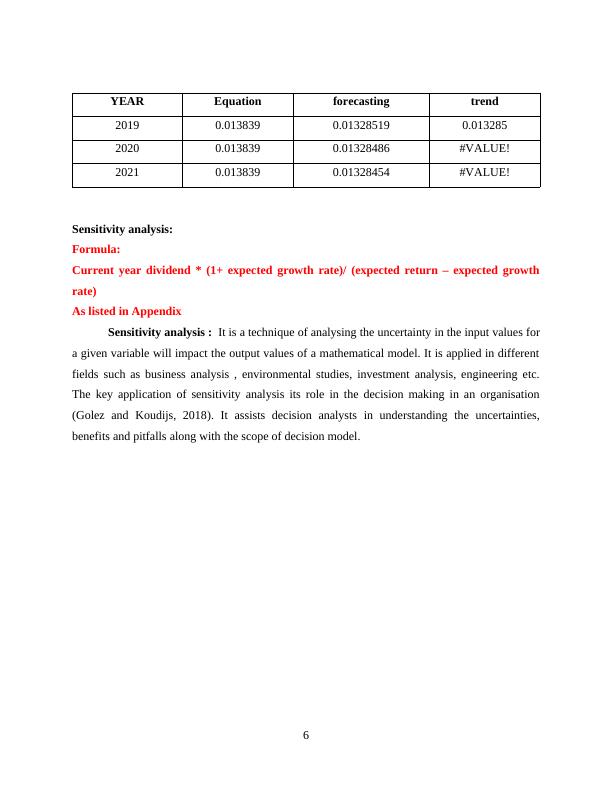
End of preview
Want to access all the pages? Upload your documents or become a member.
Related Documents
Financial Performance Analysis of Qantas Airwayslg...
|20
|4490
|470
Dupont analysis Assignmentlg...
|8
|2338
|80
RATIO FORMULA Also referred to as….lg...
|1
|124
|17
DuPont Analysis: Return on Equity Analysislg...
|5
|585
|422
Security Analysis Valuation and Investmentlg...
|15
|3401
|208
Commercial Banking and Finance: DuPont Analysis and Industry Evaluationlg...
|14
|2989
|364
